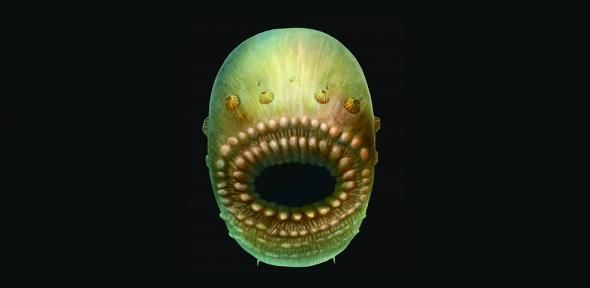Humans’ Earliest Known Ancestor, Saccorhytus Coronarius, Was A Microscopic, Bag-Like Sea Creature

Saccorhytus coronarius. That, according to a study published Monday in the journal Nature, is the name of our oldest known ancestor.
If the conclusions of the study, based on analysis of microfossils found in China, are correct, then Saccorhytus — which, under an electron microscope, looks like the face of a Xenomorph from Ridley Scott’s “Alien” — was not only the earliest known ancestor of humans, it was also the progenitor of a huge variety of other species.
“We think that as an early deuterostome this may represent the primitive beginnings of a very diverse range of species, including ourselves,” study co-author Simon Conway Morris from the University of Cambridge, said in a statement. “To the naked eye, the fossils we studied look like tiny black grains, but under the microscope the level of detail is jaw-dropping. All deuterostomes had a common ancestor, and we think that is what we are looking at here.”
Deuterostome is a broad category that includes animals ranging from the gigantic blue whale to the tiny arrow worm. Until now, the earliest deuterostomes scientists have discovered were between 510 and 520 million years old, when they had already begun to diversify into vertebrates, sea squirts, echinoderms such as starfish and sea urchins, and hemichordates.
The Saccorhytus microfossils that were found in central China’s Shaanxi Province, on the other hand, are estimated to be about 540 million years old — dating back to the early Cambrian period, when the region would have been a shallow sea. According to the authors of the study, Saccorhytus’ small size would have allowed it to live between grains of sediment on the ocean floor, where it most probably fed on other tiny creatures using its strikingly large mouth that may also have served the function of an anus.
“If that was the case, then any waste material would simply have been taken out back through the mouth, which from our perspective sounds rather unappealing,” Conway Morris said.
In addition, the creature was also bilaterally symmetrical — a trait inherited by many of its descendants, including humans — and was covered with a thin, relatively flexible skin suggestive of some kind of musculature that helped it wiggle around.
“Our team has notched up some important discoveries in the past, including the earliest fish and a remarkable variety of other early deuterostomes,” co-author Degan Shu from Northwest University in China, said in the statement. “Saccorhytus now gives us remarkable insights into the very first stages of the evolution of a group that led to the fish, and ultimately, to us.”
© Copyright IBTimes 2024. All rights reserved.






















